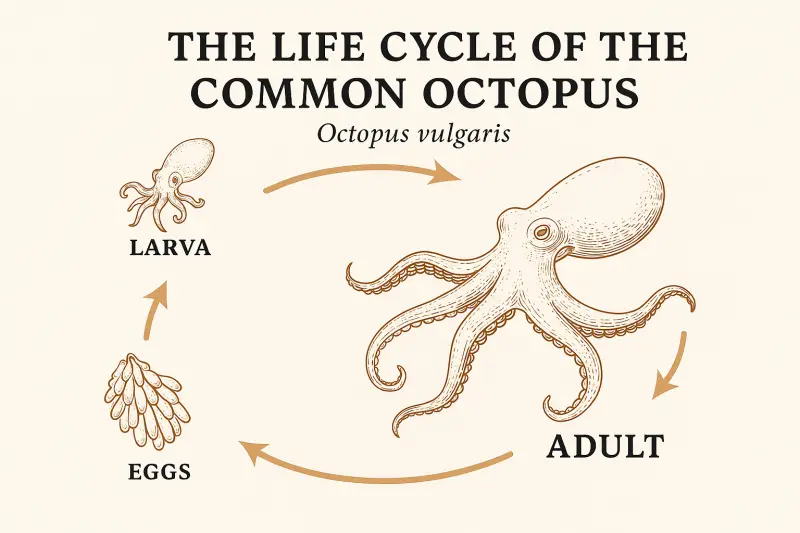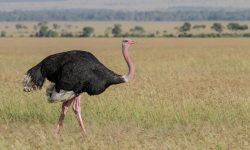The ocean is filled with extraordinary creatures, but few are as fascinating as the common octopus (Octopus vulgaris). Known for its intelligence, camouflage, and flexibility, this cephalopod is a master of adaptation. Yet, behind its mysterious behavior lies a remarkable story of transformation — one that begins as a tiny, drifting larva and ends as one of the ocean’s most skilled predators.
The life cycle of the common octopus is short but extraordinary. In just one to two years, it progresses through dramatic stages: from a microscopic egg to a free-floating larva, then to a growing juvenile, and finally to a mature adult ready to reproduce. Each phase reveals something new about the octopus’s biology, survival strategies, and evolutionary brilliance.
In this detailed guide, we’ll explore the complete life cycle of the common octopus, including its reproduction, growth, intelligence, and the bittersweet end that defines its existence.
Understanding the Common Octopus

The common octopus (Octopus vulgaris) is found in tropical and temperate waters around the world — from the Atlantic Ocean to the Mediterranean and even the Pacific. It prefers shallow coastal zones, rocky reefs, and seagrass beds where it can blend seamlessly with its surroundings.
Physical Characteristics
- Eight muscular arms lined with suckers used for gripping, exploring, and manipulating objects.
- Soft, boneless body that allows it to squeeze through openings as small as its eye.
- Highly developed eyes capable of detecting polarized light for precise vision.
- Three hearts — two for pumping blood to the gills and one for circulating oxygenated blood throughout the body.
- Blue blood, due to hemocyanin, which carries oxygen more efficiently in cold, low-oxygen waters.
The common octopus is one of the most intelligent invertebrates known to science. Its short lifespan is offset by exceptional learning ability, problem-solving skills, and adaptability — all of which play critical roles throughout its life cycle.
Stage 1: Reproduction – The Beginning of Life
The life cycle of the common octopus starts dramatically — with an act of reproduction that will ultimately end both parents’ lives.
Courtship and Mating
Octopuses are solitary by nature, but during breeding season, males actively search for receptive females. Courtship involves cautious approaches, color changes, and arm gestures that signal intent.
The male uses a specially adapted arm called the hectocotylus to transfer spermatophores (packets of sperm) into the female’s mantle cavity. This process can last several hours, and in many cases, the male dies shortly after mating — a phenomenon linked to the hormonal changes that follow reproduction.
Egg-Laying and Maternal Care
After fertilization, the female lays up to 500,000 tiny eggs in protected dens or crevices, attaching them in clusters that resemble delicate white strings. She meticulously guards and cleans the eggs for up to two months, fanning them with her arms to provide oxygen and remove debris.
During this period, the female stops eating entirely. Her sole purpose becomes protecting her offspring. Once the eggs hatch, her energy reserves are depleted, and she dies — completing her self-sacrificial role in the cycle of life.
This maternal devotion ensures that at least some hatchlings survive in the unpredictable world of the ocean.
Stage 2: Egg and Embryo Development
Each egg is no larger than a grain of rice, yet inside lies the blueprint for one of the ocean’s most complex creatures.
Embryo Growth
During incubation, the embryos gradually develop visible features — arms, eyes, chromatophores (color cells), and a mantle. The mother continuously ventilates and guards them, ensuring that temperature and oxygen levels remain ideal.
The Moment of Hatching
After about 50 to 80 days, depending on water temperature, the embryos hatch into tiny larvae called paralarvae. At this stage, they are barely 2–3 millimeters long, almost transparent, and completely defenseless. They immediately drift into the plankton-rich upper ocean layers, beginning life as part of the plankton community.
Only a fraction of these paralarvae will survive. Predation, currents, and environmental factors take a heavy toll — but those that do endure will eventually grow into the next stage.
Stage 3: Paralarval Stage – Life in the Plankton
The paralarval stage is one of the most vulnerable yet crucial phases in the life cycle of the common octopus.
Drifting and Feeding
As planktonic organisms, paralarvae float near the ocean surface, carried by tides and currents. They feed on microscopic crustaceans, small zooplankton, and larvae of other marine animals. Their transparent bodies help them avoid predators, while their chromatophores begin to develop, hinting at the color-changing mastery they’ll later display.
Survival Challenges
This stage can last from one to three months, depending on environmental conditions. Predators such as fish, jellyfish, and larger plankton feed heavily on paralarvae. Fewer than 1% survive to settle on the seafloor — but those that do represent the next generation of skilled hunters.
Stage 4: Juvenile Octopus – Life on the Ocean Floor
Once paralarvae settle on the seabed, they undergo metamorphosis into juvenile octopuses. They develop more defined arms, stronger muscles, and the behavioral patterns of adults.
Learning to Hunt
Juvenile octopuses begin hunting immediately. Their diet includes crustaceans, small fish, worms, and mollusks. Using stealth, speed, and intelligence, they ambush prey by shooting out their arms and enveloping victims in their web-like body.
They also use camouflage and mimicry to hide from predators. By expanding or contracting chromatophores, they can instantly change skin color and texture, blending seamlessly into sand, rocks, or coral.
Building a Home
Juveniles construct dens in crevices or burrows, using shells and stones as walls. These dens serve as both shelter and hunting bases. They are known to decorate and rearrange their surroundings — an early sign of their problem-solving intelligence.
Growth and Maturity
Growth is rapid during this stage. Juveniles shed and replace skin layers while increasing body size severalfold. Within six to twelve months, they reach full maturity, depending on water temperature and food availability.
Stage 5: Adult Octopus – The Peak of Intelligence
The adult stage is the most active and recognizable period in the octopus’s life. Fully grown common octopuses can reach 3 feet (1 meter) in length, with arms spanning wider.
Diet and Hunting Techniques
Adult octopuses are opportunistic carnivores. Their diet includes:
- Crabs and lobsters
- Shrimp
- Fish
- Clams and scallops
- Other cephalopods (including smaller octopuses)
They are skilled hunters that rely on a mix of stealth, strategy, and brute strength. Using their beak-like mouth, they puncture prey shells and inject venom that paralyzes or dissolves tissues.
One remarkable technique involves using coconut shells or rocks as tools to capture and trap prey — a rare example of tool use among invertebrates.
Intelligence and Behavior
Adult common octopuses are incredibly smart. They can solve mazes, recognize individuals, unscrew jars, and even escape enclosures. Their brains are proportionally large — roughly the size of a walnut — and two-thirds of their neurons are located in their arms, giving each limb semi-independent control.
This intelligence aids survival, communication, and adaptation in constantly changing marine environments.
Stage 6: Reproduction and the End of Life
Once maturity is reached, the octopus focuses entirely on reproduction — the final chapter in its short but remarkable life.
The Reproductive Drive
Hormonal changes trigger mating behavior. Males become more active, searching for females and displaying bright color patterns during courtship. After mating, both sexes begin to decline.
Males die soon after transferring sperm, while females devote themselves entirely to egg care. During this time, the optic gland releases hormones that suppress hunger and initiate senescence — programmed aging that leads to death.
The Cycle Restarts
When the female’s eggs hatch and the paralarvae drift into the open sea, the mother’s role is complete. Her death nourishes the surrounding ecosystem, and her offspring continue the cycle of transformation — from egg to larva to hunter, and finally to parent once again.
The Lifespan of the Common Octopus
The common octopus has a surprisingly short lifespan — usually one to two years. Environmental factors like temperature and food supply can slightly extend or shorten this time.
Their brief life, however, is packed with intelligence, adaptability, and ecological importance. By living fast and reproducing prolifically, they maintain a stable population and support countless marine species that depend on them for food.
The Role of the Common Octopus in the Ecosystem
Octopuses play a crucial role in maintaining the balance of marine ecosystems.
- As predators, they regulate crustacean and mollusk populations.
- As prey, they feed larger animals like sharks, eels, and dolphins.
- As recyclers, their remains and dens enrich marine habitats with nutrients.
They are also keystone species in many environments — their behavior influences not only prey populations but also habitat structures through burrowing and scavenging.
Fascinating Facts About the Common Octopus
- Masters of Disguise: They can change color, texture, and even body posture in less than a second.
- Escape Artists: Octopuses can fit through openings smaller than their eyeballs.
- Venomous Hunters: All octopus species produce venom, but Octopus vulgaris uses it primarily for subduing prey.
- Regeneration: They can regrow lost arms within weeks.
- Sleep and Dreaming: Studies suggest octopuses experience REM-like sleep cycles — possibly even dreaming.
- Tool Use: They use coconut shells, shells, and rocks as portable shelters or traps.
- Short-Lived Geniuses: Despite their high intelligence, most common octopuses live less than two years.
Conservation and Human Impact
Although the common octopus is not endangered, overfishing, pollution, and climate change threaten its populations in certain regions. Rising sea temperatures and habitat degradation disrupt their breeding and larval development cycles.
Sustainable fishing practices, marine protected areas, and responsible seafood consumption are key to ensuring their long-term survival. Researchers also study octopuses for insights into neural networks, robotics, and environmental adaptability — proving that protecting them benefits science and biodiversity alike.
FAQs About the Life Cycle of the Common Octopus
How long do common octopuses live?
They typically live for 12 to 24 months, depending on environmental conditions.
Do octopuses die after laying eggs?
Yes. Females die shortly after their eggs hatch, and males die soon after mating due to hormonal changes.
What do baby octopuses eat?
Paralarvae feed on zooplankton, small crustaceans, and larval shrimp while floating near the ocean surface.
How many eggs can a common octopus lay?
Up to 500,000 eggs in a single clutch, though only a tiny fraction survive to adulthood.
Are octopuses social animals?
Generally, no. They are solitary, interacting only during mating or territorial disputes.
Conclusion
The life cycle of the common octopus is one of nature’s most dramatic and awe-inspiring stories. From a fragile egg to a cunning, intelligent predator, each stage reflects a deep evolutionary mastery of survival in the ocean’s ever-changing environment.
Though their lives are short, octopuses leave a profound legacy — not only as predators and prey but also as symbols of intelligence, adaptability, and sacrifice. They remind us that even brief lives can have extraordinary purpose and impact.
The next time you watch an octopus glide through the water, remember that behind its graceful movements lies a story of transformation, instinct, and resilience — the complete life cycle of the common octopus.






